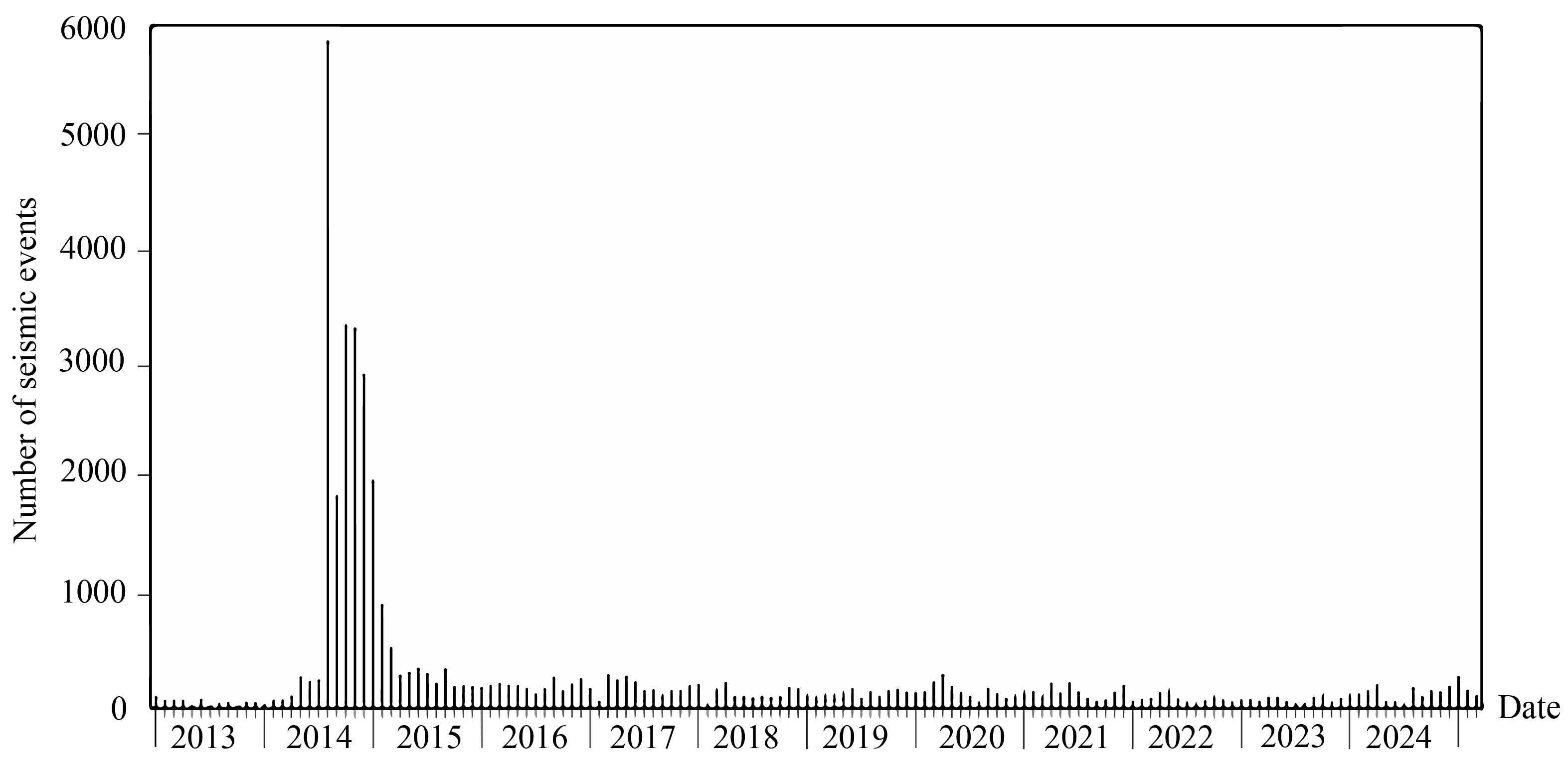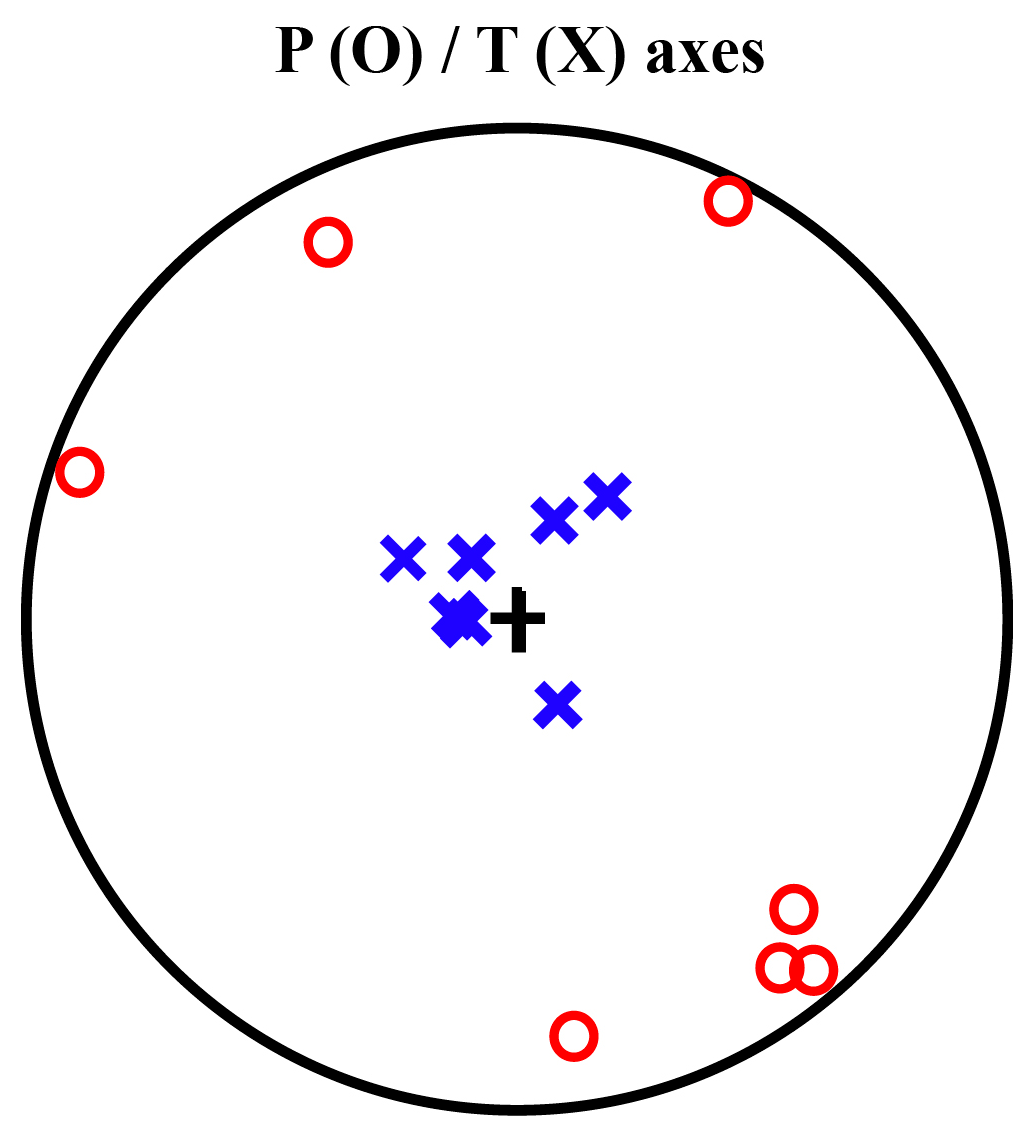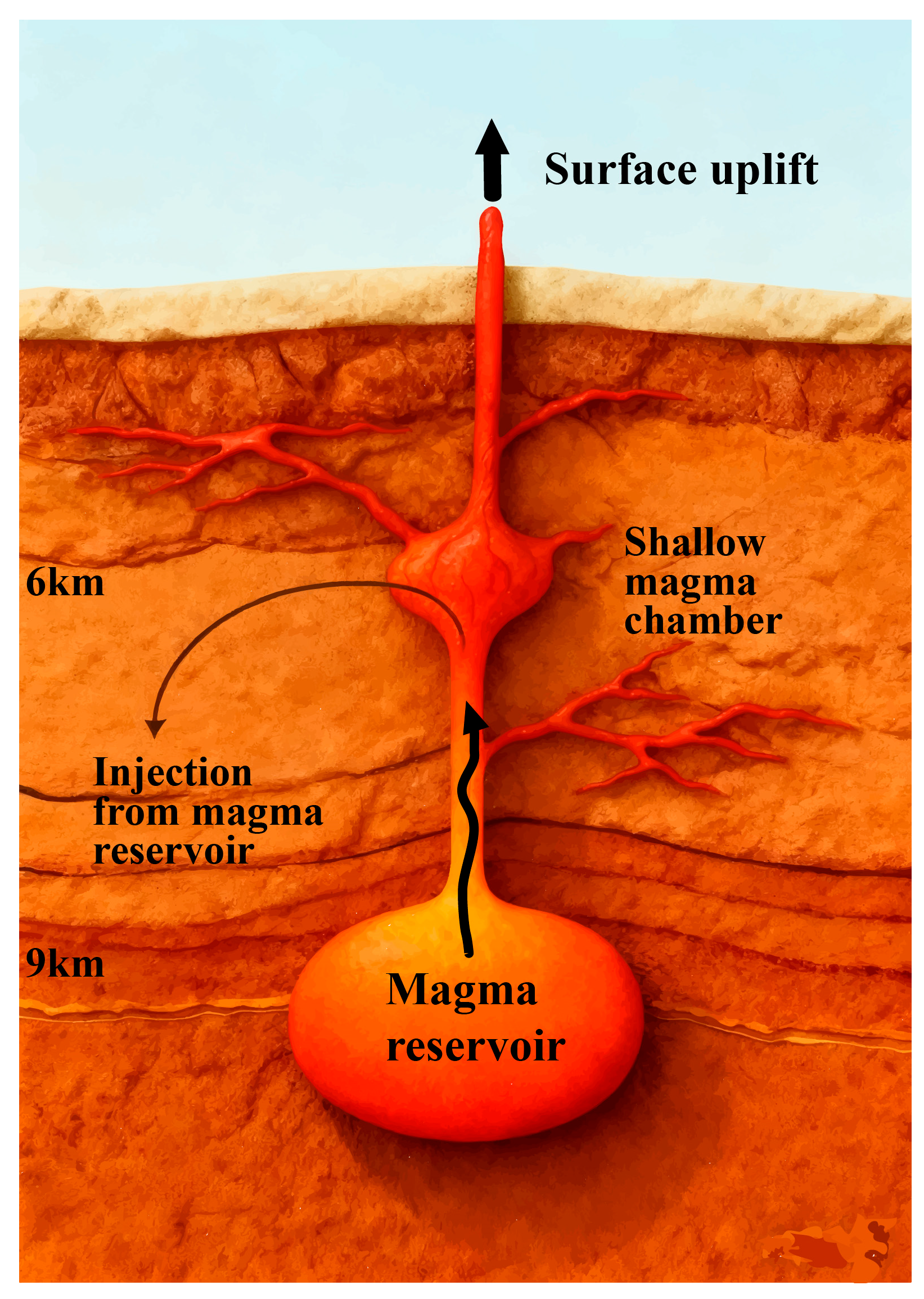Focal Mechanism of 2020–2025 Mw > 5.0 Earthquake Sequence in Bárðarbunga Volcanic Zone, Iceland, and Its Implications for Magma Inflow Activity
Abstract
1. Introduction

2. Data and Methods
3. Results
4. Discussion
4.1. Isotropic Component
4.2. Possible Non-Double-Couple Mechanisms
4.3. Possible Magma Inflow Activity
5. Conclusions
Supplementary Materials
Author Contributions
Funding
Data Availability Statement
Conflicts of Interest
References
- Ward, P.L. New Interpretation of the Geology of Iceland. GSA Bull. 1971, 82, 2991–3012. [Google Scholar] [CrossRef]
- Rojas, O.; Monterrubio-Velasco, M.; Rodríguez, J.E.; Callaghan, S.; Abril, C.; Halldorsson, B.; Kowsari, M.; Bayat, F.; Olsen, K.B.; Gabriel, A.A.; et al. Earthquake Fault Rupture Modeling and Ground-Motion Simulations for the Southwest Iceland Transform Zone Using CyberShake. Bull. Seismol. Soc. Am. 2024, 115, 69–85. [Google Scholar] [CrossRef]
- Sæmundsson, K. Outline of the geology of Iceland (Yfirlit um jarðfræði Íslands). Jökull 2023, 29, 7–28. [Google Scholar] [CrossRef]
- Li, S.; Sigmundsson, F.; Drouin, V.; Parks, M.M.; Ófeigsson, B.G.; Jónsdóttir, K.; Grapenthin, R.; Geirsson, H.; Hooper, A.; Hreinsdóttir, S. Ground Deformation After a Caldera Collapse: Contributions of Magma Inflow and Viscoelastic Response to the 2015–2018 Deformation Field Around Bárðarbunga, Iceland. J. Geophys. Res. Solid Earth 2021, 126, e2020JB020157. [Google Scholar] [CrossRef]
- Ágústsdóttir, T.; Woods, J.; Greenfield, T.; Green, R.G.; White, R.S.; Winder, T.; Brandsdóttir, B.; Steinthórsson, S.; Soosalu, H. Strike-slip faulting during the 2014 Bárðarbunga-Holuhraun dike intrusion, central Iceland. Geophys. Res. Lett. 2016, 43, 1495–1503. [Google Scholar] [CrossRef]
- Einarsson, P.; Brandsdóttir, B.; Gudmundsson, M.T.; Björnsson, H.; Grínvold, K.; Sigmundsson, F. Center of the Iceland hotspot experiences volcanic unrest. Eos Trans. Am. Geophys. Union 1997, 78, 369–375. [Google Scholar] [CrossRef]
- Gudmundsson, M.T.; Jónsdóttir, K.; Hooper, A.; Holohan, E.P.; Halldórsson, S.A.; Ófeigsson, B.G.; Cesca, S.; Vogfjörd, K.S.; Sigmundsson, F.; Högnadóttir, T.; et al. Gradual caldera collapse at Bárdarbunga volcano, Iceland, regulated by lateral magma outflow. Science 2016, 353, aaf8988. [Google Scholar] [CrossRef] [PubMed]
- Nettles, M.; Ekström, G. Faulting mechanism of anomalous earthquakes near Bárdarbunga Volcano, Iceland. J. Geophys. Res. Solid Earth 1998, 103, 17973–17983. [Google Scholar] [CrossRef]
- Islam, M.T.; Sturkell, E.; LaFemina, P.; Geirsson, H.; Sigmundsson, F.; Ólafsson, H. Continuous subsidence in the Thingvellir rift graben, Iceland: Geodetic observations since 1967 compared to rheological models of plate spreading. J. Geophys. Res. Solid Earth 2016, 121, 321–338. [Google Scholar] [CrossRef]
- Jakobsson, S.; Jónasson, K.; Sigurdsson, I. The three igneous rock series of Iceland. Jökull 2008, 58, 117–138. [Google Scholar] [CrossRef]
- Kahl, M.; Bali, E.; Guðfinnsson, G.H.; Neave, D.A.; Ubide, T.; van der Meer, Q.H.A.; Matthews, S. Conditions and Dynamics of Magma Storage in the Snæfellsnes Volcanic Zone, Western Iceland: Insights from the Búðahraun and Berserkjahraun Eruptions. J. Petrol. 2021, 62, egab054. [Google Scholar] [CrossRef]
- Matrau, R.; Klinger, Y.; Thorðarson, T.; Guðmundsdóttir, E.R.; Avşar, U.; Parisi, L.; Fittipaldi, M.; Jónsson, S. Evidence for Holocene Earthquakes along the Húsavík-Flatey Fault in North Iceland: Implications for the Seismic Behavior of Oceanic Transform Faults. Bull. Seismol. Soc. Am. 2024, 114, 1966–1993. [Google Scholar] [CrossRef]
- Thordarson, T.; Larsen, G. Volcanism in Iceland in historical time: Volcano types, eruption styles and eruptive history. J. Geodyn. 2007, 43, 118–152. [Google Scholar] [CrossRef]
- Glastonbury-Southern, E.; Winder, T.; White, R.S.; Brandsdóttir, B. Ring Fault Slip Reversal at Bárðarbunga Volcano, Iceland: Seismicity During Caldera Collapse and Re-Inflation 2014–2018. Geophys. Res. Lett. 2022, 49, e2021GL097613. [Google Scholar] [CrossRef]
- Sigmundsson, F.; Hooper, A.; Hreinsdóttir, S.; Vogfjörd, K.S.; Ófeigsson, B.G.; Heimisson, E.R.; Dumont, S.; Parks, M.; Spaans, K.; Gudmundsson, G.B.; et al. Segmented lateral dyke growth in a rifting event at Bárðarbunga volcanic system, Iceland. Nature 2015, 517, 191–195. [Google Scholar] [CrossRef] [PubMed]
- Eiriksdottir, E.S.; Galeczka, I.M.; Gislason, S.R. Continuous measurements of riverine chemical constituents reveal the environmental effect of the 2014–2015 Bárðarbunga eruption in Iceland. J. Volcanol. Geotherm. Res. 2020, 392, 106766. [Google Scholar] [CrossRef]
- Jónsdótti, K. Bardarbunga Volcano (Iceland): M 4.9 Quake, Continuous Inflation Since 2015. Available online: https://www.volcanodiscovery.com/bardarbunga/news.html (accessed on 10 November 2025).
- Icelandic Meteorological Office. Available online: https://en.vedur.is/ (accessed on 26 October 2025).
- Smithsonian Institution National Museum of Natural History Global Volcanism Program. Available online: https://volcano.si.edu/showreport.cfm?wvar=GVP.WVAR20250108-373030 (accessed on 5 November 2025).
- Bachèlery, P. Understanding the Geological History of Volcanoes: An Essential Prerequisite to Their Monitoring. In Hazards and Monitoring of Volcanic Activity 1; Wiley: Hoboken, NJ, USA, 2022; pp. 1–74. [Google Scholar] [CrossRef]
- Thompson, G. Seismic Monitoring of Volcanoes; Springer: Berlin/Heidelberg, Germany, 2015; pp. 1–25. [Google Scholar] [CrossRef]
- Hudson, T.S.; White, R.S.; Greenfield, T.; Ágústsdóttir, T.; Brisbourne, A.; Green, R.G. Deep crustal melt plumbing of Bárðarbunga volcano, Iceland. Geophys. Res. Lett. 2017, 44, 8785–8794. [Google Scholar] [CrossRef]
- Konstantinou, K.; Kao, H.; Lin, C.H.; Liang, W.T. Analysis of Broadband regional waveforms of the September 29, 1996 earthquake at Bardarbunga volcano, centrral Iceland. Geophys. J. Int. 2003, 154, 134–145. [Google Scholar] [CrossRef]
- Volcano Discovery. Available online: https://www.volcanodiscovery.com (accessed on 26 October 2025).
- Julian, B.R.; Miller, A.D.; Foulger, G.R. Non-double-couple earthquake mechanisms at the Hengill-Grensdalur Volcanic Complex, Southwest Iceland. Geophys. Res. Lett. 1997, 24, 743–746. [Google Scholar] [CrossRef]
- Li, H.; Chang, X. A review of the microseismic focal mechanism research. Sci. China Earth Sci. 2021, 64, 351–363. [Google Scholar] [CrossRef]
- Foulger, G.R. Hengill Triple Junction, SW Iceland 1. Tectonic Structure And The Spatial And Temporal Distribution Of Local Earthquakes. J. Geophys. Res. Solid Earth 1988, 93, 13493–13506. [Google Scholar] [CrossRef]
- Julian, B.; Miller, A.; Foulger, G. Non-double-couple earthquakes. 1. Theory. Rev. Geophys. 1998, 36, 525–549. [Google Scholar] [CrossRef]
- Julian, B.; Foulger, G. Non-Double-Couple Earthquake Mechanisms. 2009. Available online: https://www.researchgate.net/publication/228836707_Non-Double-Couple_Earthquake_Mechanisms (accessed on 13 November 2025).
- Miller, A.D.; Foulger, G.R.; Julian, B.R. Non-double-couple earthquakes 2. Observations. Rev. Geophys. 1998, 36, 551–568. [Google Scholar] [CrossRef]
- Rösler, B.; Spencer, B.D.; Stein, S. Which Global Moment Tensor Catalog Provides the Most Precise Non-Double-Couple Components? Seismol. Res. Lett. 2024, 95, 2444–2451. [Google Scholar] [CrossRef]
- Rösler, B.; Stein, S. Consistency of Non-Double-Couple Components of Seismic Moment Tensors with Earthquake Magnitude and Mechanism. Seismol. Res. Lett. 2022, 93, 1510–1523. [Google Scholar] [CrossRef]
- Oliva, S.J.; Ebinger, C.J.; Wauthier, C.; Muirhead, J.D.; Roecker, S.W.; Rivalta, E.; Heimann, S. Insights Into Fault-Magma Interactions in an Early-Stage Continental Rift From Source Mechanisms and Correlated Volcano-Tectonic Earthquakes. Geophys. Res. Lett. 2019, 46, 2065–2074. [Google Scholar] [CrossRef]
- Rodríguez-Cardozo, F.; Hjörleifsdóttir, V.; Jónsdóttir, K.; Iglesias, A.; Franco, S.I.; Geirsson, H.; Trujillo-Castrillón, N.; Hensch, M. The 2014–2015 complex collapse of the Bárðarbunga caldera, Iceland, revealed by seismic moment tensors. J. Volcanol. Geotherm. Res. 2021, 416, 107275. [Google Scholar] [CrossRef]
- Xu, Y.; Wen, L. Non-Double-Couple Components of Seismic Source: Method and Application to the 2014–2015 Bárðarbunga Volcanic Event Sequence, Iceland. J. Geophys. Res. Solid Earth 2024, 129, e2023JB028592. [Google Scholar] [CrossRef]
- Knopoff, L.; Randall, M.J. The compensated linear-vector dipole: A possible mechanism for deep earthquakes. J. Geophys. Res. 1970, 75, 4957–4963. [Google Scholar] [CrossRef]
- Tkalčić, H.; Dreger, D.S.; Foulger, G.R.; Julian, B.R. The Puzzle of the 1996 Bárdarbunga, Iceland, Earthquake: No Volumetric Component in the Source Mechanism. Bull. Seismol. Soc. Am. 2009, 99, 3077–3085. [Google Scholar] [CrossRef]
- Vavryčuk, V. Moment tensor decompositions revisited. J. Seismolog. 2014, 19, 231–252. [Google Scholar] [CrossRef]
- NSF Seismological Facility for the Advancement of Geoscience (SAGE). Available online: https://ds.iris.edu/wilber3/find_event (accessed on 26 October 2025).
- GEOFON and EIDA Data Archives. Available online: http://eida.gfz.de/webdc3/ (accessed on 26 October 2025).
- Incorporated Research Institutions for Seismology. Available online: https://ds.iris.edu/wilber3/ (accessed on 26 October 2025).
- Zhu, L.; Rivera, L.A. A note on the dynamic and static displacements from a point source in multilayered media. Geophys. J. Int. 2002, 148, 619–627. [Google Scholar] [CrossRef]
- Yao, Z.X.; Harkrider, D.G. A generalized reflection-transmission coefficient matrix and discrete wavenumber method for synthetic seismograms. Bull. Seismol. Soc. Am. 1983, 73, 1685–1699. [Google Scholar]
- Zhu, L.; Ben-Zion, Y. Parametrization of general seismic potency and moment tensors for source inversion of seismic waveform data. Geophys. J. Int. 2013, 194, 839–843. [Google Scholar] [CrossRef]
- Zhao, L.-S.; Helmberger, D. Source Estimation from Broad-Band Regional Seismograms. Bull. Seismol. Soc. Am. 1994, 84, 91–104. [Google Scholar]
- Zhu, L.; Helmberger, D.V. Advancement in source estimation techniques using broadband regional seismograms. Bull. Seismol. Soc. Am. 1996, 86, 1634–1641. [Google Scholar] [CrossRef]
- Luo, Y.; Zhao, L.; Zeng, X.; Gao, Y. Focal mechanisms of the Lushan earthquake sequence and spatial variation of the stress field. Sci. China Earth Sci. 2015, 58, 1148–1158. [Google Scholar] [CrossRef]
- Yi, G.X.; Long, F.; Zhang, Z.W. Spatial and temporal variation of focal mechanisms for aftershocks of the 2008 MS8.0 Wenchuan earthquake. Chin. J. Geophys. 2012, 55, 1213–1227. (In Chinese) [Google Scholar] [CrossRef]
- Li, H.; Chang, X.; Hao, J. Hydraulic Fracturing Shear/Tensile/Compressive Crack Investigation Using Microseismic Data. Remote Sens. 2024, 16, 1902. [Google Scholar] [CrossRef]
- Chiang, A.; Ichinose, G.A.; Dreger, D.S.; Ford, S.R.; Matzel, E.M.; Myers, S.C.; Walter, W.R. Moment Tensor Source-Type Analysis for the Democratic People’s Republic of Korea–Declared Nuclear Explosions (2006–2017) and 3 September 2017 Collapse Event. Seismol. Res. Lett. 2018, 89, 2152–2165. [Google Scholar] [CrossRef]
- Křížová, D.; Málek, J. Focal Mechanisms of West Bohemia, Central Europe, Earthquakes—End of May 2014: Evidence of Volume Changes. Seismol. Res. Lett. 2021, 92, 3398–3415. [Google Scholar] [CrossRef]
- Yang, T.; Shen, Y. P-wave velocity structure of the crust and uppermost mantle beneath Iceland from local earthquake tomography. Earth Planet. Sci. Lett. 2005, 235, 597–609. [Google Scholar] [CrossRef]
- Du, Z.J.; Foulger, G.R. The crustal structure beneath the northwest fjords, Iceland, from receiver functions and surface waves. Geophys. J. Int. 1999, 139, 419–432. [Google Scholar] [CrossRef]
- Laske, G.; Masters, G.; Ma, Z.; Pasyanos, M.E. Update on CRUST1.0—A 1-Degree Global Model of Earth’s Crust. 2013. Available online: http://www.meetingorganizer.copernicus.org/EGU2013/EGU2013-2658.pdf (accessed on 13 November 2025).
- Zhu, L.-F.; Pan, X.; Sun, J.-Z. Visualization and dissemination of global crustal models on virtual globes. Comput. Geosci. 2016, 90, 34–40. [Google Scholar] [CrossRef]
- Luo, F.; Yan, J.Y.; Fu, G.M.; Luo, L.; Tao, X.; Wang, H. Crust 1. 0 crustal model and its application: An example fromMiddle- Lower Yangtze Metallogenic Belt. Acta Geol. Sin. 2020, 94, 648–660. [Google Scholar] [CrossRef]
- Klein, F.W. User’s Guide to HYPOINVERSE-2000, a Fortran Program to Solve for Earthquake Locations and Magnitudes; 2002-171; US Geological Survey: Herndon, VA, USA, 2002; p. 123.
- Crotwell, H.P.; Owens, T.J.; Ritsema, J. The TauP Toolkit: Flexible Seismic Travel-time and Ray-path Utilities. Seismol. Res. Lett. 1999, 70, 154–160. [Google Scholar] [CrossRef]
- Buland, R.; Chapman, C.H. The computation of seismic travel times. Bull. Seismol. Soc. Am. 1983, 73, 1271–1302. [Google Scholar]
- Hrubcová, P.; Doubravová, J.; Vavryčuk, V. Non-double-couple earthquakes in 2017 swarm in Reykjanes Peninsula, SW Iceland: Sensitive indicator of volcano-tectonic movements at slow-spreading rift. Earth Planet. Sci. Lett. 2021, 563, 116875. [Google Scholar] [CrossRef]
- Hrubcová, P.; Vavryčuk, V. Tectonic stress changes related to plate spreading prior to the 2021 Fagradalsfjall eruption in SW Iceland. Tectonophysics 2023, 851, 229761. [Google Scholar] [CrossRef]
- Hrubcová, P.; Vavryčuk, V.; Fischer, T.; Doubravová, J. Stress variations and non-shear earthquakes before the 2021 Iceland eruption trace magmatic fluid flow. Commun. Earth Environ. 2025, 6, 575. [Google Scholar] [CrossRef]
- Büyükakpınar, P.; Isken, M.P.; Heimann, S.; Dahm, T.; Kühn, D.; Starke, J.; López Comino, J.Á.; Cesca, S.; Doubravová, J.; Gudnason, E.Á.; et al. Understanding the Seismic Signature of Transtensional Opening in the Reykjanes Peninsula Rift Zone, SW Iceland. J. Geophys. Res. Solid Earth 2025, 130, e2024JB029566. [Google Scholar] [CrossRef]
- Miller, A.D.; Julian, B.R.; Foulger, G.R. Three-dimensional seismic structure and moment tensors of non-double-couple earthquakes at the Hengill–Grensdalur volcanic complex, Iceland. Geophys. J. Int. 1998, 133, 309–325. [Google Scholar] [CrossRef]
- Gudmundsson, A. Infrastructure and mechanics of volcanic systems in Iceland. J. Volcanol. Geotherm. Res. 1995, 64, 1–22. [Google Scholar] [CrossRef]
- Wessel, P.; Luis, J.F.; Uieda, L.; Scharroo, R.; Wobbe, F.; Smith, W.H.F.; Tian, D. The Generic Mapping Tools Version 6. Geochem. Geophys. Geosyst. 2019, 20, 5556–5564. [Google Scholar] [CrossRef]
- Lupei Zhu’s Home Page. Available online: https://www.eas.slu.edu/People/LZhu/home.html (accessed on 26 October 2025).







| UTC Time | Latitude | Longitude | Depth | Moment Magnitude (Mw) |
|---|---|---|---|---|
| (°) | (°) | (km) | ||
| 20 April 2020, 03:54:51 | 64.68 | 17.48 | 10 | 5.1 |
| 21 February 2023, 08:41:05 | 64.71 | 17.68 | 10 | 5.2 |
| 24 October 2023, 22:19:47 | 64.69 | 17.57 | 10 | 5.2 |
| 6 October 2024, 17:56:30 | 64.67 | 17.23 | 10 | 5.3 |
| 14 January 2025, 08:05:23 | 64.58 | 17.64 | 10 | 5.2 |
| 22 February 2025, 21:04:48 | 64.69 | 17.52 | 10 | 5.1 |
| 27 July 2025, 23:40:03 | 64.58 | 17.29 | 10 | 5.3 |
| Origin Time | Fault Plane 1 | Fault Plane 2 | DC (%) | CLVD (%) | Mw | Depth (km) | Beach Ball | ||||
|---|---|---|---|---|---|---|---|---|---|---|---|
| Strike (°) | Dip (°) | Rake (°) | Strike (°) | Dip (°) | Rake (°) | ||||||
| 20 April 2020 | 295 | 50 | 99 | 109 | 41 | 79 | 50 | 50 | 4.9 | 6 |  |
| 21 February 2023 | 181 | 57 | 62 | 45 | 42 | 126 | 65 | 35 | 5.4 | 7 |  |
| 24 October 2023 | 251 | 30 | 75 | 88 | 61 | 98 | 48 | 52 | 5.3 | 5 |  |
| 6 October 2024 | 233 | 33 | 90 | 53 | 57 | 90 | 42 | 58 | 5.2 | 9 |  |
| 14 January 2025 | 64 | 30 | 90 | 244 | 60 | 90 | 53 | 47 | 5.3 | 6 |  |
| 22 February 2025 | 238 | 38 | 102 | 43 | 53 | 81 | 43 | 57 | 5.1 | 6 |  |
| 27 July 2025 | 237 | 26 | 105 | 41 | 65 | 83 | 58 | 42 | 5.3 | 7 |  |
Disclaimer/Publisher’s Note: The statements, opinions and data contained in all publications are solely those of the individual author(s) and contributor(s) and not of MDPI and/or the editor(s). MDPI and/or the editor(s) disclaim responsibility for any injury to people or property resulting from any ideas, methods, instructions or products referred to in the content. |
© 2025 by the authors. Licensee MDPI, Basel, Switzerland. This article is an open access article distributed under the terms and conditions of the Creative Commons Attribution (CC BY) license (https://creativecommons.org/licenses/by/4.0/).
Share and Cite
Hou, B.; Li, H.; Chang, X.; Hao, J.; Zhang, S.; Ye, Q. Focal Mechanism of 2020–2025 Mw > 5.0 Earthquake Sequence in Bárðarbunga Volcanic Zone, Iceland, and Its Implications for Magma Inflow Activity. J. Mar. Sci. Eng. 2025, 13, 2172. https://doi.org/10.3390/jmse13112172
Hou B, Li H, Chang X, Hao J, Zhang S, Ye Q. Focal Mechanism of 2020–2025 Mw > 5.0 Earthquake Sequence in Bárðarbunga Volcanic Zone, Iceland, and Its Implications for Magma Inflow Activity. Journal of Marine Science and Engineering. 2025; 13(11):2172. https://doi.org/10.3390/jmse13112172
Chicago/Turabian StyleHou, Benhao, Han Li, Xu Chang, Jinlai Hao, Suxiang Zhang, and Qing Ye. 2025. "Focal Mechanism of 2020–2025 Mw > 5.0 Earthquake Sequence in Bárðarbunga Volcanic Zone, Iceland, and Its Implications for Magma Inflow Activity" Journal of Marine Science and Engineering 13, no. 11: 2172. https://doi.org/10.3390/jmse13112172
APA StyleHou, B., Li, H., Chang, X., Hao, J., Zhang, S., & Ye, Q. (2025). Focal Mechanism of 2020–2025 Mw > 5.0 Earthquake Sequence in Bárðarbunga Volcanic Zone, Iceland, and Its Implications for Magma Inflow Activity. Journal of Marine Science and Engineering, 13(11), 2172. https://doi.org/10.3390/jmse13112172






